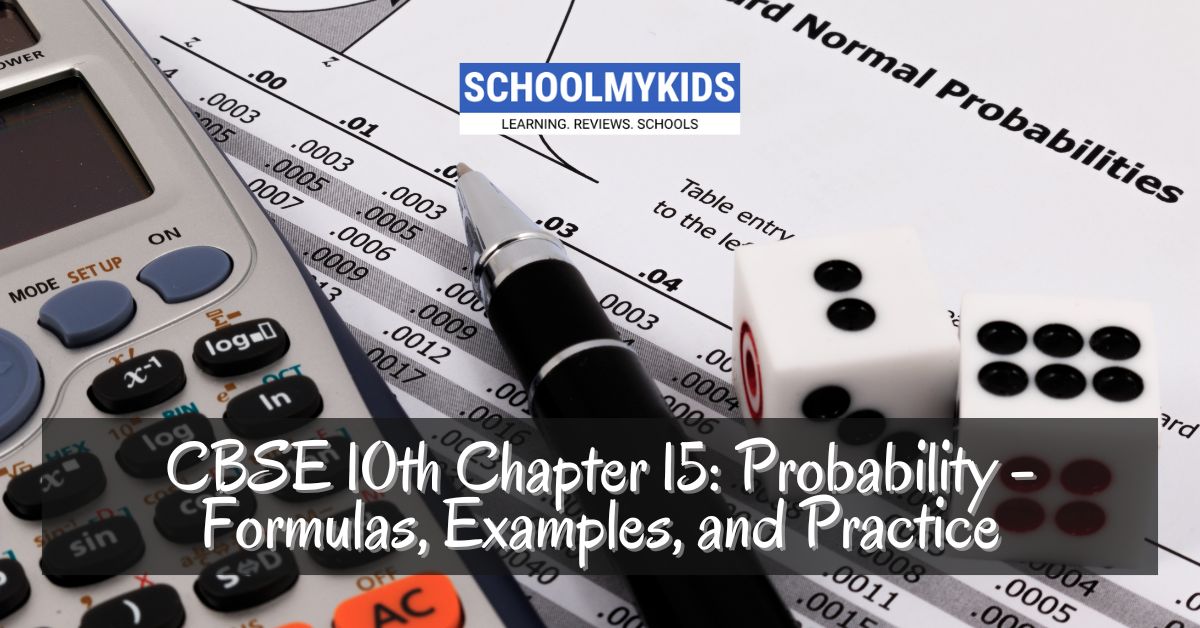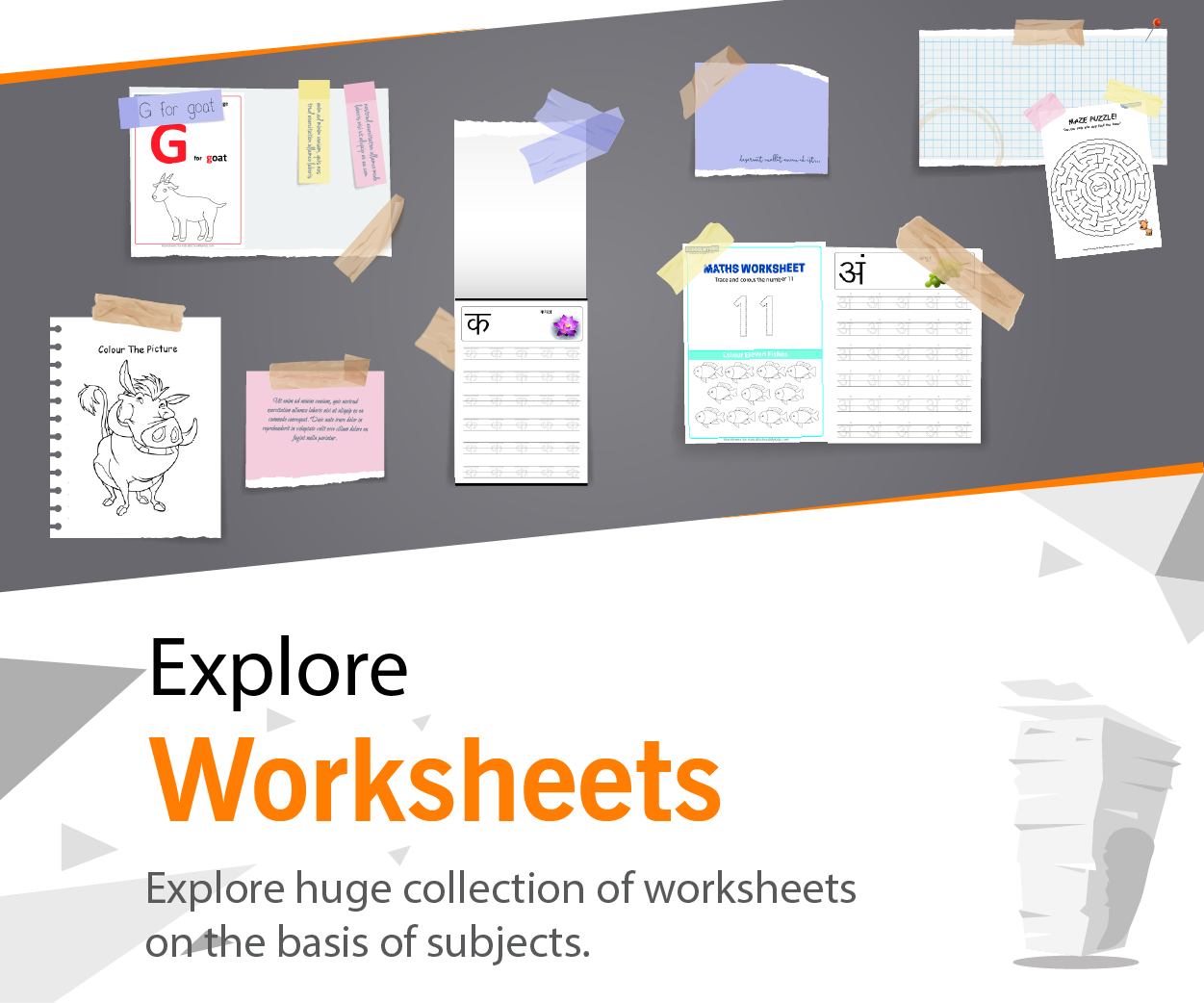This chapter ventures into the world of probability, exploring the likelihood of events occurring. We’ll focus on calculating probabilities for basic events, independent and dependent events, and conditional probability.
Probability deals with the likelihood of events happening. Here are the two main approaches:
- Theoretical Probability: Calculated based on possible outcomes (n(S)) and favorable outcomes (n(E)). P(E) = n(E) / n(S).
- Example: A bag has 3 red marbles and 2 blue marbles. What’s the probability of picking a red marble?
- Explanation: n(S) = total outcomes (picking any marble) = 3 (red) + 2 (blue) = 5. n(E) = favorable outcome (picking red) = 3. P(red) = 3/5.
- Example: A bag has 3 red marbles and 2 blue marbles. What’s the probability of picking a red marble?
- Empirical Probability: Based on observations or experiments.
- Example: You roll a die 100 times and observe a 6 appearing 16 times. Find the empirical probability of getting a 6.
- Explanation: Empirical Probability = Favorable outcomes (number of 6s) / Total outcomes (number of rolls) = 16/100.
- Example: You roll a die 100 times and observe a 6 appearing 16 times. Find the empirical probability of getting a 6.
Formulas
- Sample Space (S): The collection of all possible outcomes in an experiment.
- Event (E): A subset of the sample space representing a specific outcome or group of outcomes.
- Probability (P(E)): The likelihood of event E occurring. It’s expressed as a number between 0 (impossible) and 1 (certain), often represented as a decimal or fraction.
Probability Calculations:
- Theoretical Probability: P(E) = Favorable Outcomes / Total Possible Outcomes (Assuming all outcomes are equally likely)
- Frequency Probability: P(E) = Number of Favorable Outcomes / Total Number of Trials (Based on observations or experiments)
Events:
- Independent Events: Events whose occurrences do not affect each other (e.g., flipping a coin twice)
- Dependent Events: Events where the outcome of one affects the probability of the other (e.g., drawing a card from a deck without replacement)
Conditional Probability (P(E2 | E1)): The probability of event E2 occurring given that event E1 has already happened.
Additional Formulas (Advanced Topics):
- Permutations (Order Matters): P(n items) = n! (n factorial)
- Combinations (Order Doesn’t Matter): P(n choose k) = n! / (k! * (n-k)!)
Examples
1. Flipping a Coin:
- Sample Space (S): {Heads, Tails}
- Event (E): Getting heads
- Probability (P(E)): There are two equally likely outcomes (heads or tails), so P(Heads) = 1 favorable outcome / 2 total outcomes = ½
2. Rolling a Die:
- Sample Space (S): {1, 2, 3, 4, 5, 6}
- Event (E): Rolling an even number
- Probability (P(E)): There are 3 favorable outcomes (2, 4, 6) and 6 total possible outcomes, so P(Even) = 3 favorable / 6 total = ½
3. Drawing Cards (Dependent Events):
A deck has 52 cards. We draw a card (without replacement) and then draw another card.
- Event (E1): Drawing a heart (13 hearts)
- Event (E2): Drawing a spade after a heart (13 spades remaining)
- P(E1): 13 hearts / 52 total cards = ¼
- P(E2 | E1): Since a heart was drawn first, there are only 39 cards remaining. Also, one spade has been removed. So, P(Spade after Heart) = 12 spades remaining / 39 total remaining cards ≈ 0.31 (after calculating the probability as a fraction and converting to a decimal)
Advanced Topics
- Permutations: If you need to arrange items in a specific order (e.g., finding the number of unique arrangements of letters in a word), use permutations.
- Combinations: When the order doesn’t matter (e.g., selecting a group of people from a team), use combinations.
Practice Questions
- A bag contains 3 red marbles, 2 blue marbles, and 1 yellow marble. What is the probability of drawing a red marble?
- A box has 4 white balls and 6 black balls. You draw one ball, don’t replace it, and then draw another ball. What is the probability of drawing a white ball, then a black ball? (Consider dependent events)
- A club has 10 seniors and 5 juniors. If two members are chosen at random to represent the club, what is the probability that both are seniors? (Consider order – use permutations)
- A coin has two sides: heads and tails. What is the probability of getting heads when you toss it once? (Explain how you reached the answer.)
- You draw a card from a well-shuffled deck of 52 cards. What is the probability of drawing a heart (considering suit only)? (Explain your reasoning.)
- Is theoretical probability always more accurate than empirical probability? Why or why not?
- Describe a situation where you might use theoretical probability and another where you might use empirical probability.
- How can the concept of probability be helpful in everyday life?
Previous Year Questions (Examples):
- A spinner has 4 equal sections numbered 1, 2, 3, and 4. What is the probability of landing on an even number?
- A bag contains 5 red marbles and 3 blue marbles. A marble is drawn at random and replaced. What is the probability of drawing a red marble or a blue marble? (Consider independent events)
- There are 7 boys and 3 girls in a class. A student is selected at random. What is the probability that the chosen student is a girl?
These are just a few examples. The actual previous year questions might differ depending on the specific exam
Conquering Equations: Practice Makes Perfect!
Here are 10 questions with explanations to solidify your understanding of solving linear equations in two variables, followed by 5 previous year questions:
Questions (1-5): Elimination Method
- Question: Solve the system: x + 2y = 5 and 3x – y = 4 (using elimination)
- Explanation: Add the top and bottom equations. Notice that the y terms eliminate: (x + 2y) + (3x – y) = 5 + 4 –> 4x + y = 9. We can’t eliminate x easily here, so let’s try substitution.
- Question: Solve the system: 2x – 3y = -1 and 4x + y = 11 (using elimination)
- Explanation: Multiply the top equation by -1: -2x + 3y = 1. Add the top and bottom equations: (-2x + 3y) + (4x + y) = 1 + 11 –> 5y = 12 –> y = 12/5. Substitute y back into either original equation to solve for x.
- Question: Solve the system: 5x + 2y = 17 and x – 4y = -3 (using elimination)
- Explanation: Notice the coefficients of x are already additive inverses. Add the top and bottom equations: (5x + 2y) + (x – 4y) = 17 – 3 –> 6x – 2y = 14. Solve for x using elimination (if needed) and then substitute to find y.
- Question: Priya cycles x km and walks y km every day for exercise. The total distance covered is 12 km, and cycling takes 30 minutes more than walking per km. Represent this situation algebraically and solve for x and y (using elimination).
- Explanation: Let the time taken to cycle 1 km be c minutes and the time taken to walk 1 km be w minutes. We know c = w + 30. The total distance and time can be expressed as: x + y = 12 and xc + yw = distance × time (here distance per unit time is speed, so total distance × speed = total time). Substitute the first equation into the second and eliminate y to solve for x. Then substitute x back into the first equation to find y.
- Question: A fruit vendor buys apples and oranges. Each apple costs ₹2 and each orange costs ₹3. He buys a total of 25 fruits for ₹61. Represent this situation algebraically and solve for the number of apples and oranges bought (using elimination).
- Explanation: Let the number of apples be a and the number of oranges be o. The total number of fruits and their cost can be expressed as: a + o = 25 and 2a + 3o = 61. Eliminate a to solve for o and then substitute o back into the first equation to find a.
Questions (6-8): Substitution Method
- Question: Solve the system: x – 2y = 3 and 3x + y = 4 (using substitution)
- Explanation: Solve the first equation for x: x = 2y + 3. Substitute this expression for x in the second equation: 3(2y + 3) + y = 4 –> 6y + 9 + y = 4 –> 7y + 9 = 4 –> 7y = -5 –> y = -5/7. Substitute y back into x = 2y + 3 to find x.
- Question: 3y = 2x + 9 and 2x – y = 1 (using substitution)
- Explanation: Solve the first equation for y: y = (2x + 9)/3. Substitute this expression for y in the second equation: 2x – ((2x + 9)/3) = 1 –> 6x – (2x + 9) = 3 –> 4x – 9 = 3 –> 4x = 12 –> x = 3. Substitute x back into y = (2x + 9)/3 to find y.
- Question:
- Explanation: Let the distance covered downstream be d and the distance covered upstream be u. We know the speed downstream (15 km/h) and upstream (10 km/h), and the total time spent traveling (4 hours). We can represent this as: d/15 + u/10 = 4. We are also given that the distance covered downstream is 5 km more than upstream (d = u + 5). Substitute this expression for d in the first equation and solve for u. Then substitute u back into d = u + 5 to find the distance covered downstream.
Questions (9-10): Graphical Method
- Question: Graph the equations: y = x + 2 and y = 2x – 1. Find the point of intersection.
- Explanation: Plot both equations following the steps mentioned earlier (find intercepts and slopes). The point of intersection is where the lines cross.
- Question: Two trains leave stations A and B at the same time and travel towards each other. Train A travels 10 km/h faster than Train B. The total distance between the stations is 300 km. After 3 hours, they meet. Find the speeds of both trains (using the graphical method).
- Explanation: Let the speed of Train B be x km/h. Then, Train A’s speed is (x + 10) km/h. The total distance can be represented as the sum of the distances traveled by both trains in 3 hours. Since they travel towards each other, the total distance is the sum of their speeds multiplied by time (distance = speed × time). Graphically, this can be shown by plotting lines representing the distance traveled by each train (starting from 0 km at 0 hours) until they meet at a point representing the total distance (300 km) after 3 hours. The slopes of these lines will be the speeds of the trains (slope = distance/time). By analyzing the graph, you can determine the speeds of both trains.
Previous Year Questions (2023-2018)
2023: Solve the system of equations: 3x + 2y = 11 and x – y = 2 (using elimination or substitution).
2022: The sum of three consecutive terms of an AP is 12. Find the terms. (This question is not related to linear equations in two variables, but is from Chapter 5: Arithmetic Progressions)
2021: In an AP, the 7th term is 36 and the 13th term is 62. Find the first term and the common difference. (This question is not related to linear equations in two variables, but is from Chapter 5: Arithmetic Progressions)
2020: Solve the system of equations: 2x + y = 7 and x – 3y = -5 (using elimination or substitution).
2019: The length of a rectangle is 5 cm more than its breadth. If the perimeter of the rectangle is 60 cm, find the length and breadth. Represent this situation algebraically and solve for the length and breadth. (This can be solved using linear equations in two variables)
By practicing these questions and understanding the explanations, you’ll be well-equipped to tackle any linear equation problems you encounter in your CBSE Class 10 Maths exam!









Be the first one to comment on this story.